Background and Introduction
Robert Tyabji, Dar es Salaam 1995
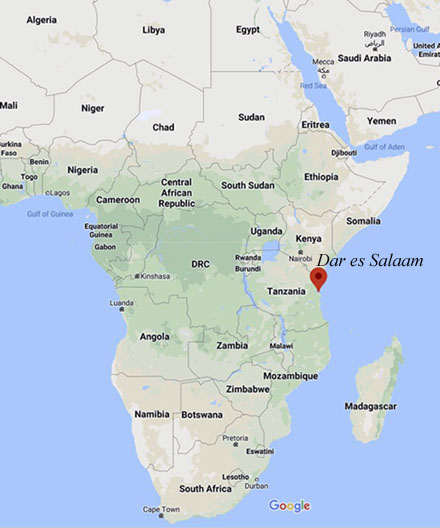
Tanzania (formerly Tanganyika) in East Africa is known for its vast wilderness areas which include eight national parks and many game reserves. Serengeti, Ngorongoro Crater, Ruaha, Tarangire and Kilimanjaro, home to Africa’s highest mountain, are among the parks most sought after by tourists. The parks teem with elephant, lion, leopard, buffalo, rhino, cheetah, wildebeest, zebra and a bewildering range of land, water and airborne wildlife. The phenomenon of almost two million wildebeest and 20,000 plains game crossing the crocodile-infested Mara River to migrate annually from Tanzania's Serengeti to Kenya's Masai Mara (and vice versa) in search of lush grazing grounds and life-giving water has been called "the greatest show on earth". Offshore lie the tropical islands of Zanzibar and Mafia with a marine park home to whale sharks and coral reefs.
The country is mountainous and densely forested in the north-east, where Mount Kilimanjaro is located. Three of Africa's Great Lakes - Lake Victoria, Africa's largest, Lake Tanganyika, Africa's deepest, and Lake Malawi - are partly within Tanzania.
Many important hominid fossils have been found in Tanzania, such as 6-million-year-old Pliocene fossils. The genus Australopithecus ranged all over Africa 4 to 2 million years ago; and the oldest remains of the genus Home are found near Lake Olduvai. Following the rise of Home erectus 1.8 million years ago, humanity spread as Homo sapiens all over the world. One of the oldest known ethnic groups still existing, the Hadzabe, appears to have originated in Tanzania, and their oral history recalls ancestors who were tall and were the first to use fire and medicine.
German rule began in mainland Tanzania during the late 19th century when Germany formed German East Africa. This was followed by British rule to form the United Republic of Tanzania. Tanzania has been ruled by a democratic socialist party, the Chama Cha Mapinduzi, since 1977.
The population of about 60 million comprises spme 120 ethnic, linguistic, and religious groups. Tanzania is a presidential constitutional republic and since 1996 its official capital city has been Dodoma. Dar es Salaam, the former capital, retains many government offices and is the country's largest city, principal port, and leading commercial centre.
Over 100 different languages are spoken, making it the most linguistically diverse country in East Africa, and while the national language is Swahili, English is widely spoken.
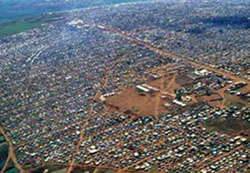 Our transition from Yemen to Tanzania happened at a crucial time in African history, in the immediate aftermath of the Rwandan genocide which took place between 7 April and 15 July 1994. 500,000 to a million Tutsi, Twa and moderate Hutu citizens were murdered, and an estimated half a million women were raped. The genocide had lasting and profound effects on Rwanda and neighbouring countries. Half a million Rwandans fleeing the genocide streamed into Tanzania, and nearly a million into Zaire, creating one of the world's worst refugee crises.
Our transition from Yemen to Tanzania happened at a crucial time in African history, in the immediate aftermath of the Rwandan genocide which took place between 7 April and 15 July 1994. 500,000 to a million Tutsi, Twa and moderate Hutu citizens were murdered, and an estimated half a million women were raped. The genocide had lasting and profound effects on Rwanda and neighbouring countries. Half a million Rwandans fleeing the genocide streamed into Tanzania, and nearly a million into Zaire, creating one of the world's worst refugee crises.
Getting there
To my relief I was transferred from Yemen in July of 1994, just as the Yemen civil war was ending. Hootoksi and all the UN families as well as hundreds of thousands of foreign personnel had been evacuated weeks before. The truce brought about a deafening silence in a desolate Sana'a emptied of most of its inhabitants who had returned to their homes and villages around the country. All that was left of the UN was half a dozen 'essential' staff (including yours truly). 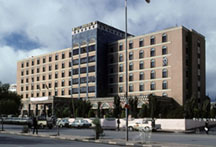 All of us were holed up at the Taj Sheba Hotel as our homes had been deemed unsafe and it was considered desirable to keep us together. (I thought this policy actually exposed us to greater harm as we were now bunched together along with all the foreign news correspondents in one of the most prominent buildings in Yemen, a prime target, but the UN Resident Representative believed otherwise. We were fortunate that the southern separatists were either not interested in us or were not very good shots!)
All of us were holed up at the Taj Sheba Hotel as our homes had been deemed unsafe and it was considered desirable to keep us together. (I thought this policy actually exposed us to greater harm as we were now bunched together along with all the foreign news correspondents in one of the most prominent buildings in Yemen, a prime target, but the UN Resident Representative believed otherwise. We were fortunate that the southern separatists were either not interested in us or were not very good shots!)
During the past couple of weeks as the war was toning down and there was nothing much to do by way of official work, I'd had time to go home to pack our personal belongings and whatever furniture and equipment was left over from our going-away sale, as well as our heirloom and other precious pieces (shown in Family Treasures on this site). Luckily, our Indian houseboy Mohamad was still around to help! Our 20-foot container had been kept for us and used as storage for the past five years by the US Embassy and this was returned so I packed everything in it and left it in UNICEF's care for later shipment to Tanzania.
As often happens in post-war situations, all commercial flights to and from Yemen had been suspended. So how was I to get to Dar es Salaam?
I had been a lucky so-and-so till now, and my luck held at this crucial time! Our good friend Steve Watson from Halliburton, who had also remained behind, was at that moment in time organizing a chartered flight out of Yemen for many of the oil people, and there were a few seats to spare! The flight stopped in Djibouti to refuel and then dropped some of us off in Athens. After a couple of days enjoying the Athenian sights, sounds and smells, I got connections to Dar es Salaam - and was catapulted into another warlike situation created by the influx of two million desperate refugees fleeing the genocide in Rwanda.
Our Home on Old Bagamoyo Road
Hootoksi Tyabji, Dar es Salaam, July 1994
Finding a house to rent in Dar es Salaam was a challenge! There were few estate agents around, rents were exorbitant, basic utilities like water and power were unreliable and one often ended up having to pay for a water truck (bowser) to fill one's tanks. Electricity was erratic, so everyone wanted to rent a house that came with a generator or a UPS converter.
We were staying at the best hotel on Chole Road (as suggested by UNICEF) for the first two months when one day the phone rang. It was Mr John, an estate agent, who announced he had the perfect house for me. We arranged to meet in the lobby at ten the next morning. Most of the agents I had been with had no car, I had to rent a cab to go around with them, but this gentleman said he would drive me in his car.
At 11 am there was still no sign of Mr. John and I was about to give up on him when I saw a man at the reception desk, inquiring for someone’s room. I ran up and asked him “Are you Mr. John?” and he said “Yes” so I introduced myself and not wanting to waste any more time, I walked out of the front door and he followed, but there seemed to be no car, and he said he didn’t have one! There were no taxis around and I was beginning to want to wrap it up when I noticed he was carrying a crash helmet. “Shall we go on your bike?” “Yes” he replied and where shall we go?” I was beginning to get annoyed but held my tongue and said, “Take me to the house that has both water and a generator” “OK” he beamed and so I got on the back of his rather rickety old scooter and we drove, and we drove and we drove. I began getting worried, we seemed to be leaving town and I had no idea where we were going so I tapped him on the shoulder and got him to stop. “Where are you taking me?” I asked “Anywhere!” he replied “But where is the house? Are you Mr. John the estate agent?” “No,” he replied, “I am Mr. John the taxi driver,” “So where is your taxi?” “Broken!” he said quite nonchalantly! I never did find out what happened to Mr. John the estate agent!
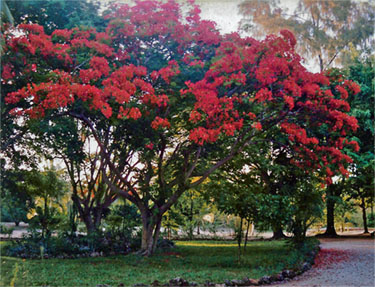
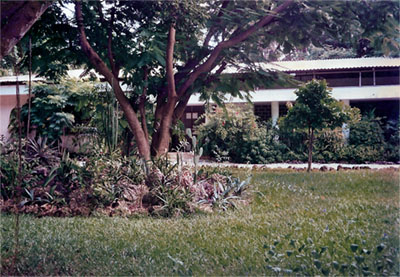 By now we were in the middle of nowhere so I asked John if he would drive me back to the hotel and he very kindly agreed. Along the way he said, "I can show you a very nice house to rent. I used to work there as a security guard. It is on old Bagamoyo road, shall I take you there?" I had nothing to lose having wasted my entire morning, so off we went and after a thirty minute ride we arrived at a gate and drove through it along a driveway into a compound filled with bamboo, large ficus and flame trees. Set in the back was a lovely old, colonial style bungalow. A portly, elderly and very friendly African mama greeted us and told Mr John in Swahili that she and her dog Bobby, were caretakers of the house. It belonged to her daughter who lived in Brussels with her Belgian husband.
By now we were in the middle of nowhere so I asked John if he would drive me back to the hotel and he very kindly agreed. Along the way he said, "I can show you a very nice house to rent. I used to work there as a security guard. It is on old Bagamoyo road, shall I take you there?" I had nothing to lose having wasted my entire morning, so off we went and after a thirty minute ride we arrived at a gate and drove through it along a driveway into a compound filled with bamboo, large ficus and flame trees. Set in the back was a lovely old, colonial style bungalow. A portly, elderly and very friendly African mama greeted us and told Mr John in Swahili that she and her dog Bobby, were caretakers of the house. It belonged to her daughter who lived in Brussels with her Belgian husband.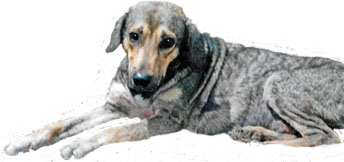
Bobby was a very sorry looking dog covered in mange and smelling from the ooze; but he had the most fabulous, fierce bark and mama told us in no uncertain terms that the dog came with the house and if I agreed we could continue talking. I promised her that if we did rent the place, Bobby could stay, so mama quoted a figure which was way above our budget! I told her I loved the place but could not afford it. She asked me to make an offer, which I did, and she said she would speak with her daughter and let me know.
I went back to the hotel and excitedly told Robert about my find but we both figured that the difference between what they wanted and what we could pay was too great, so I continued my house hunt and tried to forget about Old Bagamoyo road!
Meanwhile, we were getting fed up of the hotel and fortunately our friend Andrea Singh needed someone to house-sit for her while she was away on holiday, so we moved into her home and the heat was off the house hunt momentarily. Then out of the clear blue, Pa got a call from a lady in Brussels saying she was the owner of the house on Bagamoyo Road and she would be happy to rent us her place if we could up the rent by just a little. She brought the rent down a bit we went up and viola, we had a beautiful home to move into!
As promised, we kept Bobby on the premises and I tried to get him treatment for his condition, but nothing seemed to work. He was a fantastic guard dog, the slightest sound at the gate and his bark made people think he was a fierce Rottweiler rather than the sorry looking dog he was, and it would scare folks away!
The house was perfect! It was large, airy and full of natural light, with three large bedrooms, a spacious living area with a large alcove where we placed our bar and swing. It was set in 2 acres of sandy garden with a wide swath of sandy beach but a short walk away behind. Outside the kitchen window was a beautiful Laburnum tree that had vivid yellow flowers and the flame trees were awe inspiring when they were in full bloom! There was a disused clay tennis court which we converted into a badminton court. On Sundays, our friends would come over for a game after which we had sundowners, good music and food.
There was an outside garage for two vehicles and more than enough space beside it to comfortably accommodate our 20-foot container. Soon after we moved in we bought a Nissan Patrol 4WD short wheelbase for Robert and a Toyota Corona 4WD sedan for me.
The electrics and plumbing in the house were of an extremely high standard and we had a large capacity UPS inverter which worked seamlessly every time the power went off!
Enjoying the Monkeys in Our Yard
Hootoksi Tyabji, Dar es Salaam, 1998
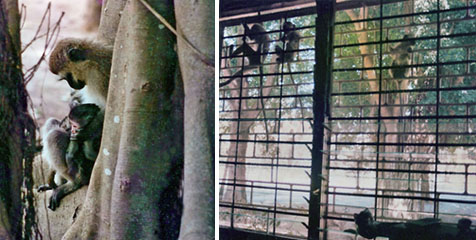 In Dar es Salaam we lived in a marvelous old bungalow that sat on 2 acres of land, with beautiful flame, Ficus, and Laburnum trees. When in bloom we had splashes of orange and yellow, a feast for our eyes! These magnificent specimens were home to a tribe of Vervet monkeys (about a dozen at any given time) and it was a joy to observe them from the house. They came through our garden everyday around 7 in the morning, stayed till around 10 or so, then disappeared and reappeared from 5 to 7 pm or thereabouts. We saw tiny babies grow into adolescents and then into adults. The family always stayed together and initially when the babies were tiny, they clung to their mothers and she to them. As time went on, ma encouraged the little ones to venture out on their own while the older siblings watched and waited chattering and screeching their encouragement or displeasure.
In Dar es Salaam we lived in a marvelous old bungalow that sat on 2 acres of land, with beautiful flame, Ficus, and Laburnum trees. When in bloom we had splashes of orange and yellow, a feast for our eyes! These magnificent specimens were home to a tribe of Vervet monkeys (about a dozen at any given time) and it was a joy to observe them from the house. They came through our garden everyday around 7 in the morning, stayed till around 10 or so, then disappeared and reappeared from 5 to 7 pm or thereabouts. We saw tiny babies grow into adolescents and then into adults. The family always stayed together and initially when the babies were tiny, they clung to their mothers and she to them. As time went on, ma encouraged the little ones to venture out on their own while the older siblings watched and waited chattering and screeching their encouragement or displeasure.
One day, I watched as a tiny little chap discovered he could jump, twist, and turn and leap from branch to branch, much the same as the others in the family. Suddenly he stopped, sat on a branch, and looked down at something long and dangling. He got hold of this and began tugging at it while the other monkeys started chattering their heads off doing cartwheels and loops and screeching with mirth! They waited and watched till the little chap realized he was pulling on his own tail! His mama who had been watching all this silently, scooped him up and the little guy buried his head in her fur not wanting to face his brothers and sisters!
Another time we noticed that a young monkey had a leather thong around his waist. He must have been captured but managed to break free and we knew that we had to get the thong off or it would strangle him as he grew!
Elton from Malawi, who worked for us, happened to know how to trap a monkey and offered to do the job. He set up a simple trap with bamboo, string, and salt (bait) to lure the monkey in. The little chap was caught in no time at all, but he was wild with fear, barring his teeth and jumping up and down. Elton was afraid to hold him, and I was too, but I grabbed him by the waist, held him over my shoulder and as he struggled to break free, I began singing a lullaby. As I sang his little body relaxed and he put his head on my shoulder, so Elton was able to cut the leather thong off his waist. Relieved and free he bounded off into the trees chattering and screeching with joy!
A friend called me one day and asked if some monks could come over and leave their pet monkey in our yard. Apparently one of the young monks befriended this monkey and kept it in the monastery but it started going into the neighbor’s corn fields and destroying their crop. When this happened repeatedly, the monks decided they had to find a home for their pet and by asking around, our home seemed a safe bet. Neither the monks nor us knew anything about integrating a lone monkey into an existing tribe so the monks and monkey arrived around 6 PM when ours were foraging as they normally did at that time. The monk held his pet close to his chest in the folds of his robe and most reluctantly set it down on the ground. It took a couple of leaps into a tree and immediately there was a huge ruckus as our monkeys began screeching and chattering and making unwelcoming gestures and sounds as soon as they discovered this stranger in their midst. The lone monkey took a minute or two to size things up and then in a flash and a single leaped into the comfort and confines of the monk’s robe! A short discussion later, the monks and the monkey drove back to their monastery and I never did follow up that story, I hope it had a happy ending!
Our Isaac Chuma
Robert Tyabji, Dar es Salaam, September 1999
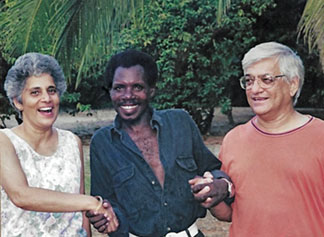 Isaac was our night guard and gateman for more than five years. He was the quintessential rascal, a prototype of the lovably naughty, charming scoundrel. He would move around on his thin scrawny legs with an exaggerated limp which made his body jerk from side to side but this didn't hamper his movements or slow him down at all. In fact, we called him Speedy Isaac because he could outrun most fit people! The gate of our compound was about 150 meters uphill from the house, but he would charge up the driveway to open it in the blink of an eye. We discovered that he had a daytime occupation as well, as a worker for the local chapter of Chama Cha Mapinduzi, the majority party in Tanzania. At night he would disappear into the bushes near the gate, there presumably to pass the night in peaceful slumber. I once stole his slippers but in truth we could not fault his effectiveness as guard for we never once suffered a break-in while he was with us, even though petty crime was rife in Dar and our compound was huge, more than two acres, and bounded only by a broken-down barbed wire fence.
Isaac was our night guard and gateman for more than five years. He was the quintessential rascal, a prototype of the lovably naughty, charming scoundrel. He would move around on his thin scrawny legs with an exaggerated limp which made his body jerk from side to side but this didn't hamper his movements or slow him down at all. In fact, we called him Speedy Isaac because he could outrun most fit people! The gate of our compound was about 150 meters uphill from the house, but he would charge up the driveway to open it in the blink of an eye. We discovered that he had a daytime occupation as well, as a worker for the local chapter of Chama Cha Mapinduzi, the majority party in Tanzania. At night he would disappear into the bushes near the gate, there presumably to pass the night in peaceful slumber. I once stole his slippers but in truth we could not fault his effectiveness as guard for we never once suffered a break-in while he was with us, even though petty crime was rife in Dar and our compound was huge, more than two acres, and bounded only by a broken-down barbed wire fence.
Isaac lived about five km. away and would walk to and from our place. He always arrived punctually at 5 pm and left early the next morning. He was very reliable and fiercely loyal to us, as long as he was sober, which to be fair was most of the time, with a few explosive exceptions. Once, while Hootoksi's parents were visiting, Isaac appeared at our door, grinning lopsidedly, swaying from side to side and obviously very drunk. I had warned him on several occasions about drinking while on duty so I scolded him and told him to go home, but he refused saying he was there to look after our safety and security, and nothing would deter him from this duty! My mother-in-law then sweetly gave him a lecture about the ills of alcohol but he just nodded and stood there, swaying and grinning. In the end, I called in Ultimate Security, the company that patrolled our area and with whom we had a contract. They arrived in a pickup, lights flashing, helmeted and with batons ready, and looked doubtfully at the swaying Isaac. They were baffled by my request to remove him from the property, wasn't he our man? Dutifully, they helped him into the back of the truck and drove away. They must have dropped him off somewhere nearby, for Isaac reappeared at the front door a few minutes later, swaying and saluting. I then realized that we were stuck with him, like it or not, until we left Tanzania for good!
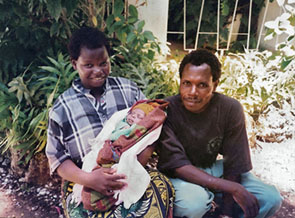
A couple of years later, Isaac announced that he was getting married. He then brought his bride Maria over to meet us, along with his year-old baby son, Wester!
We recently received a letter from Isaac which is a classic and which touched us deeply.
From Isaac Chuma, Mikocheni, Dar es Salaam
13th. July 2001
Hie Robert & Hootoksi Tyabji,
Don't be blood shocked to receive this missive letter from me Yes it's me Isaac Chuma with vigour and vitality to have this golden opportunity of placing all colours and views to you. How are you over that side of you. Telling about my body condition am okay.
The main theme which forced me to write this letter to you is to let insure that I have received your letter very well with many thanks! I also received a suit well.
Mum please don't forget to think more about myself. I really trust you because you are my Mother and Father.
More greetings from Wester CHUMA and her mother Maria. I do off my pen here.
I remain as,
ISAAC CHUMA
The Magical Secrets of the Khanga
Presentation by Hootoksi Tyabji
Diplomatic Women’s Group Coffee Morning, Dar es Salaam, 16th April 1997
 This morning I am going to share some of the magical secrets of the Khanga with you. I hope you enjoy watching our wonderful models and also learn something of the history and traditions that go along with this piece of cloth, making it one of the most versatile and interesting garments in Africa.
This morning I am going to share some of the magical secrets of the Khanga with you. I hope you enjoy watching our wonderful models and also learn something of the history and traditions that go along with this piece of cloth, making it one of the most versatile and interesting garments in Africa.
The Swahili culture, though influenced by Arabia and India, has become a unique, original and easily identifiable one, with its very own social customs and distinct styles of cuisine, music, language and dress.
The Khanga was first used as a garment on the East African coast in the late 19th century. Its name is derived from the guinea fowl or ‘leso’ which is a derivative of peso, the Portuguese word for scarf. Some believe that the first Khangas were made from several scarves which were sewn together to make a wrapper and another piece was used as a cover for the head. Others believe that the Khanga is a variation of the sarong which is a piece of cloth worn by men and women in the Far East and on the southern coast of India. This is a possibility as there was a thriving trade between these countries and the East Africa through Madagascar.
The Khanga is a rectangular piece of cloth about ¾ meters in length and 1.4 meters in width. It has a border on four sides and a central motif which often depicts a flower, fruit or plant. It is invariably made of cotton and is very comfortable to wear. What distinguishes it from other pieces of cloth are the boxed proverbs and messages printed on the lower part of the fabric. At first hKangas were used as a single piece of cloth which was tied around the body and gathered up in a pleat over the left breast. It was only in the early 1900’s that women on the East African Coast began to use two identical pieces of Khanga. One to wrap around the body and one as a head cover or shawl over the shoulders. When you buy a Khanga today, it is sold in two identical pieces.
The Khanga became popular because of its vibrant colours, its printed message and the fact that it disassociated coastal women from a connotation of slavery. Women of all social and economic classed started wearing it and for the first time, an article of clothing was responsible for the merger of different classes of women. It has been popularized by Ngoma groups who use it as a uniform for their dances because it is cheap, accessible, colourful and easy to wear!
Apart from being a versatile article of clothing, it is also used as a medium of communication. Each Khanga is printed with words that portray love, jealousy, hatred and a host of other emotions. Some have famous proverbs ad colourful poetry, while other carry social, moral and political messages. A woman buying one often considers what it says more than how it looks. The first proverb ever to be written on a Khanga was in Arabic because most people at the time were literate in Arabic having being taught how to read and write verses from the Koran. During colonial times, the British printed Khangas with Winston Churchill’s slogans to win the support of women for the war and today, Kangas are still used to spread social messages and campaign for causes such as the eradication of malaria, the benefits of education, the emancipation of women and so on.
Some messages are romantic such as “its heaven when two people are in love” and are worn by a wife for her husband, others speak to women and say things like “your husband is your property so why be jealous of him” or if one woman is blaming the other for snatching her husband she may sport a Khanga that says “I didn’t ask for him to come to me in the first place. Blame him not me!”
The colours of the Khanga also have a clear meaning and a husband will know how his wife is feeling by the colour she chooses to wear on any given day. Dark colours are used to express anger, sadness and discontent and bright colours convey happiness and joy!
Khangas serve many different purposes in a woman’s wardrobe. The infant at birth is wrapped in it and a woman is buried in one. It is used as a corset after child-birth, as diapers, bath-robe, apron, head-covering, bed sheet, curtain, table cloth and a hundred other uses. Men can only wear the Khanga in the privacy of their bed-rooms and a young girl before puberty can only wear one over her clothes but not on its own.
When the Khanga became popular in the early 1900’s traders immediately saw the potential market for them and began to manufacture them all over the world. They are to this day imported from Indonesia, India, Burma, China, and even from some parts of Europe. For Coastal women, the Khanga is an integral part of life and in our fashion show today we will share some of its secrets and magic with you. I am sure you are eager to see what we have lined up for you this morning and so without further ado let’s begin our show!
Beautiful Sabine is dressed in a Khanga that was bought for her by her mother to be worn before for her ritual bath on her wedding day. These Khangas are called Sutu. Traditionally they have a pattern on two sides and a design of crosses and rosettes. It is black, red and white and each colour denotes a different aspect of life. The red symbolizes virginity, black is the pain of being deflowered and white signifies the male seed which a bride will receive for the first time on her wedding night.
Winsome Rabiyat is wearing a dark brown Khanga with a bright yellow and black pattern which was given to her by her husband’s sister. She wore it on the eve of her wedding when she was being decorated with Wanja (a black paste made from seeds that are burned and pounded into a paste with coconut oil and is black in colour) and Henna (a red paste made from a flowering plant) The ritual bath in scented water is preceded by elaborate decorations of the hands and feet with Wanja and Henna, an integral part of any Swahili Wedding.
Molly looks stunning in her bridal green Khanga which she was allowed to choose and wear on her wedding day. It says “A person who is blessed, doesn’t suffer” She walked into the room where her husband was being given a special feast by her family, and showed off her ensemble.
Lovely Thoko is dressed in a beautiful bright blue Khanga with a yellow and white pattern and a vivid yellow border which she could wear during her wedding celebrations. Some tribes in Tanzania who do not live along the coast, will not wear the traditional Sutu during the wedding ceremonies because they believe that the three colours, black, red and white are associated with spirit possession and spirit dances and are used for exorcism. This belief is held especially by the Waganga tribe in central Tanzania
Beppie looks beautiful in a bright yellow Khanga. It has a Christian motif of flowers and candles. In her hand she carries a Khanga that is called Makaja. It is given to a daughter by her mother right after she delivers her first child, and is used as a corset to tighten her stomach muscles. There is an interesting tradition with the Makaja. It is given by a son-in-law to his new mother-in-law as compensation for her having suffered wearing it as a corset after delivering her daughter, now the bride. Unfortunately his mother gets no such gift for bearing him!!!
Attractive Laura wears this cheerful purple Khanga with a vivid green leaf and grape design. On her back she carried her baby in a Khanga sling! This baby –carrying Khanga is called an Mbeleko. Old Khangas are cut up and used as diapers for babies and many women prefer using them to commercially marketed nappies. They promise that they baby will never get nappy rash from wearing them!
Charming Thoko again, wearing a Khanga that has a message for her neighbour who she expects to see on her way to market this morning. Thoko especially bought this Khanga for the message it has printed on it and not for its design or colour. She wants to convey exactly what her Khanga says and so she will position herself where her neighbour is bound to read it. The words printed across her Khanga say “I may not be beautiful but I don’t need to sell myself!” now she has conveyed how she feels, she can go about her business for the rest of the day!
Pretty Shinta also has a bone to pick with her friend and so she makes sure that the message on her beautiful Khanga is read. It says “It is better not to mix with those whose only job it is to gossip” Her friend who reads the message rushes off to the market to buy a Khanga with a message on it to respond to that!
Beppie will now show you how she uses the Khanga of which she has several in her wardrobe. She uses it over her bikini on the beach and often spreads it out on the sand to use as a tablecloth. When it gets too hot, she uses it to cover her head and to wipe the seat off her face.
Rabiyat drapes the Khanga in a very different way – she ties it over both shoulders and wears it around the house. She finds it cool and comfortable and often also uses it at night to sleep in. She loves going to the markets and finding Khangas with unique and attractive designs and patterns. The one she is modelling is quite unique in its colour and its style.
Manoe always has Khangas around her home and she finds lots of different uses for them. She uses them as aprons, makes them into attractive sun dresses and shirts and pot holders and table mats.
And so dear ladies, we come to the end of our Khanga Parade. Please join me in giving a hearty round of applause to our sporting ladies who gamely took to the catwalk wearing a garment never worn before, and they pulled it off with aplomb!
The Africa Peace and Harmony Festival, 27 August - 4 September 2000
Robert Tyabji, Dar es Salaam
This was the first ever festival of its kind in Africa and I'm proud to say I played a key role in organizing it on behalf of UNICEF. More than 400 children attended from all over sub_Saharan Africa; 15 Rwandans, 20 Burundians, 20 South Africans, 3 Eritreans, 13 Zambians, hundreds of Tanzanian kids and 45 Burundian, Rwandan and Congolese kids from refugee camps in western Tanzania.
The children arrived in Dar a few days earlier with their escorts, their teachers or representatives of sponsor agencies, and were accommodated in nearby schools. Each group came with a play, dance, song or poem to perform during the festival. School children from around Dar and nearby towns were invited to attend the opening ceremony and the main performances at the city's central park on 27 August.
On the 27'th morning the groups paraded banners and danced through downtown Dar es Salaam to the city's main park for more performances, and in the evening there were special events organized for them at the Diamond Jubilee Hall.
Among the many wonderful performances was a poem recited in Kirundi by a young Burundian refugee girl. Called A Cry for Peace, it was a poignant and brutally honest statement composed by Burundian, Congolese and Rwandan children from Tanzania's refugee camps, whose definitive experience of life was the poverty and hopelessness of the camps.
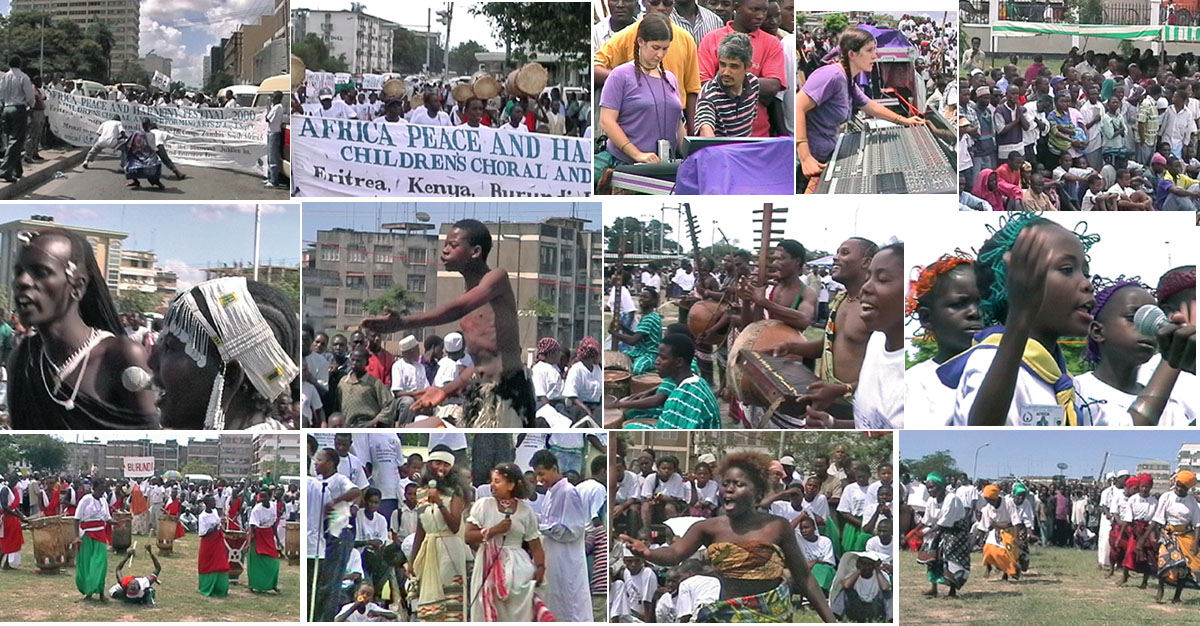
The final evening's performances were held for sponsors and invited guests at The Slipway in Msasani. As it happened, my mother was visiting us from Sydney, as well as her dear friend Nora Raymond from Bombay, and both were present to enjoy the show! And what a magnificent show it was! A special stage had been erected and Michel and Rosa (who were also in Tanzania on a government partnered cultural project) made sure that the sound quality was outstanding.
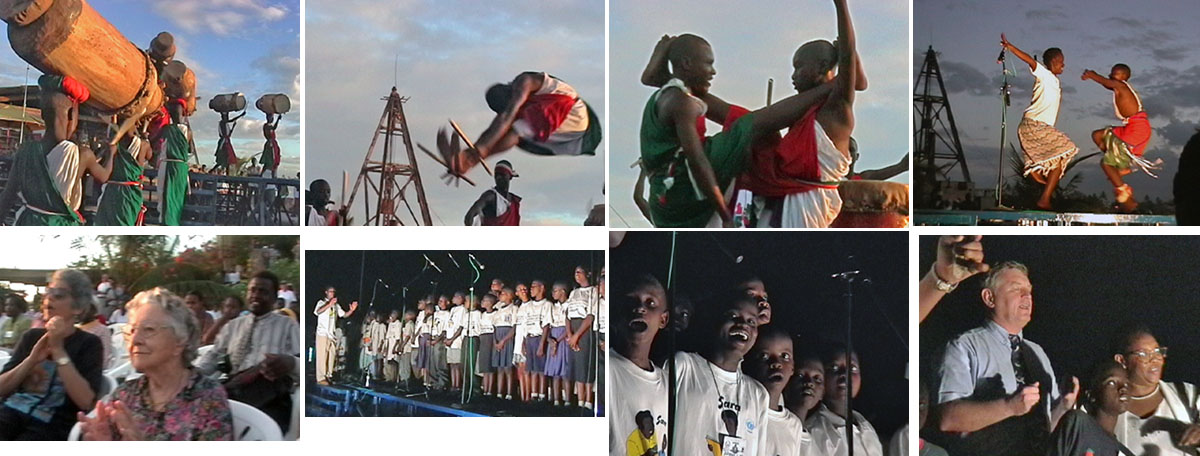
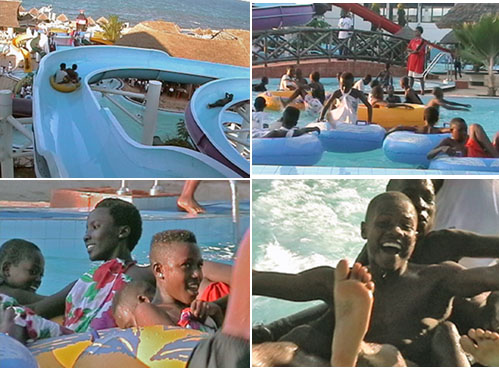
Many of the children had never seen the ocean, or played in a swimming pool. One of the festival's activities was a visit to the Dar es Salaam Water Park.
The festival showed what can be done when governments, multilateral organizations, NGOs and individuals work together. Only with such cooperation and support and the belief that the children’s messages will promote greater peace and harmony in a troubled region was it possible to bring together children from half a dozen strife-affected countries.
Our Silver Wedding Anniversary Celebrations
Hootoksi Tyabji, Dar es Salaam, 21 January 1997
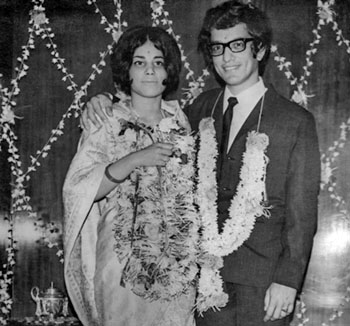
Robert & I met in Bombay in 1969, again accidently bumped into each other in Delhi in 1970 and on the 6th April 1971, we decided to get engaged. We had a Parsi engagement ceremony at my family home in Bombay.
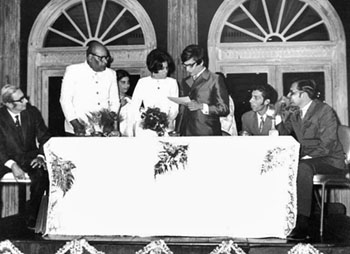 On the 8'th of December 1971 we were married in a Civil ceremony at the Taj Mahal Hotel right in the middle of the India-Pakistan war. We were the first couple to use the newly renovated Crystal Ballroom and Mr. Wani, the Marriage Officer, was brought from the court to the hotel by my uncle Jimmy, who made sure that he came in a newly laundered suit especially cleaned for the occasion! The ceremony was witnessed by Uncle Kali, Robert’s cousin Qays and his old friend Rui Jassawalla.
On the 8'th of December 1971 we were married in a Civil ceremony at the Taj Mahal Hotel right in the middle of the India-Pakistan war. We were the first couple to use the newly renovated Crystal Ballroom and Mr. Wani, the Marriage Officer, was brought from the court to the hotel by my uncle Jimmy, who made sure that he came in a newly laundered suit especially cleaned for the occasion! The ceremony was witnessed by Uncle Kali, Robert’s cousin Qays and his old friend Rui Jassawalla.
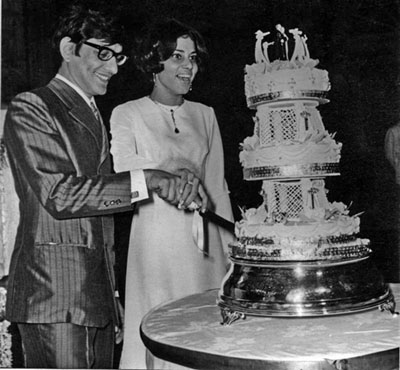 There was a reception that evening but because of the war and resulting blackouts, the guest list had been pared down from 500 to 50! Just after we signed the register, the lights went off and the sky lit up with ack-ack, and everybody had to bolt into an impromptu air raid shelter in the basement of the hotel. Dozens of guests were already there, some in their pajamas, some in their day clothes and me in my wedding gown and Rob in his shiny new suit! Some Japanese visitors in the shelter with their instamatic cameras at hand, excitedly took pictures of us in our finery! I wish I had their contact details as when we ran down into the bomb shelter, the exposed film of our wedding was left behind and when we went back to the room, all the film had been stolen! Consequently, we have very few photos of our wedding!
There was a reception that evening but because of the war and resulting blackouts, the guest list had been pared down from 500 to 50! Just after we signed the register, the lights went off and the sky lit up with ack-ack, and everybody had to bolt into an impromptu air raid shelter in the basement of the hotel. Dozens of guests were already there, some in their pajamas, some in their day clothes and me in my wedding gown and Rob in his shiny new suit! Some Japanese visitors in the shelter with their instamatic cameras at hand, excitedly took pictures of us in our finery! I wish I had their contact details as when we ran down into the bomb shelter, the exposed film of our wedding was left behind and when we went back to the room, all the film had been stolen! Consequently, we have very few photos of our wedding!
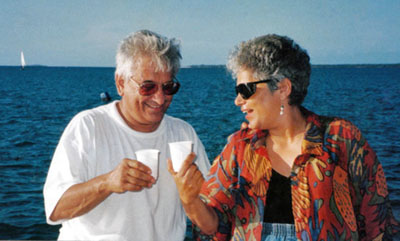
Living a nomadic lifestyle from the time we got married has had its ups and downs for the five of us, but the family consensus is that we would not have had it any other way. Most times it meant that special occasions were celebrated in far flung places with no family around us!
Our 25th Wedding Anniversary was fast approaching, and my planning for it began in May. (the anniversary was in Dec!) I decided that my gift Ito Rob would be a song that I would record for him. I chose “Love Story” and began hunting for musicians and a studio to record in at a reasonable cost. My search led me nowhere, but in November when I was beginning to dream up an alternate idea, I met John, the leader of the Masika Band and he owned a Porta Studio. He quoted a fair price for three rehearsals with the band, extra for a saxophone player and the final recording on one cassette; but in true Tanzanian fashion, things did not go to plan. We ended up doing the entire gig in one hour in a dingy, dark room that had only one chair and a table with three legs, on which there was recording gear. Forget three rehearsals, " I don’t know your song and we can’t read music. You just sing it once or twice and my boys and I will play for you” said John fiddling with wires and pushing them here and there, securing them with matchsticks! Having come this far I had nothing to lose, and to my utter amazement they picked up the tune in no time at all and did a terrific job of accompanying me, especially the saxophone player who added trills and harmony, and we were done with the recording in just about an hour. I walked out of the "studio" with a recorded cassette in my pocket and a song in my heart!
Our wedding anniversary is on the 8’th of December, but in 1996 on the 11’th. it was also UNICEF's 50th birthday, and the Ghanian Queen who was Rob's boss at the time, was going to have him fully involved and engaged in the preparations for several events, one of which was to be held on the 8th! He tried to get out of this but as far as Ms Agnes Aidoo was concerned a Silver Wedding Anniversary Celebration could wait! I was upset but had to come to terms with it, and we decided to book a balloon safari over the Serengeti National Park for the weekend following our big day, ie on the 14’th and 15’th of December.
Once that was all done and paid for, Rob informed me on the 5th that the Queen had changed plans, and now the 7th and 8th of December were free days for him! Rob was too busy at work to think of ways to celebrate and it was clearly too late for a big party so off I went in search of a romantic dinner spot for two and I headed towards the Silver Sands Hotel, 20 km. out of town and appropriately named for our silver wedding anniversary. I asked to speak to the manager who turned out to be a young South African guy with a romantic heart and a spirit to match mine! When James heard I was looking for a special setting, he pointed out to the beautiful blue ocean in front of us and said, "See that large catamaran out there in the distance? It belongs to a friend of mine and he rents it out for dive charters. Why don't you rent it for a couple of nights? I can get him to give you a good deal!"
This offer was beyond my wildest expectations and I couldn't think of a more romantic way to usher in our big day, so James and I went off to see the captain of the Catamaran and his charming wife and little dog. They agreed to cook us a terrific meal, have our favorite scotch on hand, and there was a state-of-the-art B&O sound system and video for our listening pleasure. The cost????? hey! how many times do you celebrate 25 years? All plans were sealed, and everyone was sworn to secrecy. Robert was told we were going to spend two nights at the Silver Sands Hotel, and he was happy with the plan. We drove there in our Nissan Patrol on the 7’th Dec 1996 and arrived at the hotel around 6 pm. James was at hand to greet us and offered to take us on his motor launch for a sundowner and a leisurely sail before dinner. It was a beautiful evening, there was a balmy breeze, the sky was a dark blue with the faint silhouette of a new moon and the waves were lapping the bottom of our little boat.
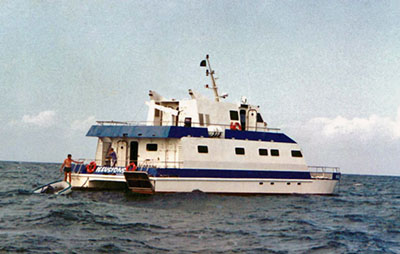
As we approached the Catamaran Rob noticed three people waving, a young friendly couple and a Tanzanian man dressed in chef's clothing. We pulled up alongside and James suggested we hop on board and it was only then that Rob noticed our overnight bag being hauled up and he twigged on to what was happening! We were warmly welcomed on board, and so began the most special 25th Wedding Anniversary Celebration. We had a wonderful candlelight dinner served by Chris, the owner of the boat, and his wife Deserie, as the chef was too seasick to do his job! Replete, we moved to the comfy couch and cuddled up to watch the wonderful old classic, Casablanca. At midnight, we walked out on deck and under a star-filled sky and the bright sliver of a new moon, we kissed and reaffirmed out deep love for each other. We exchanged gifts, opened cards from family and friends, and spoke to our children and parents. It was pure magic! I gave Rob my song and we listened to it on the wonderful sound system and laughed as I recalled the making of it!
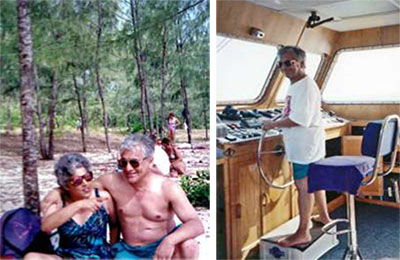
In the morning on the 8’th., after a sumptuous breakfast, we went to Mbudia Island to loll around on the beach, drink champagne, and swim. We were supposed to go back to the Silver Sands Hotel and drive our car home, but Chris offered to let Rob pilot the boat to the Slipway, a pier an hour away, and from there we could get a taxi to our house and pick up our car the following day from the hotel. With Rob happily piloting the boat we soon arrived , got off the boat in our beachwear and bumped into a friend who offered to drive us home.
As we approached our house we noticed there were many cars parked outside, several with UN number plates, but thought no more of it as we waved our friend goodbye and walked into the house to screams and shouts and cheers and whistles of “HAPPY ANNIVERSARY!”
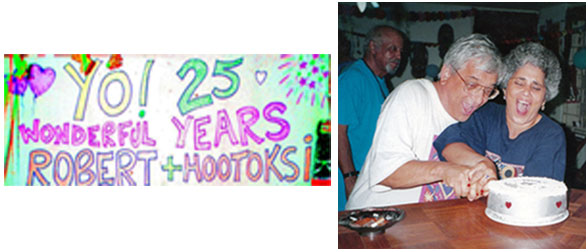
We were surrounded by friends and ushered into our living room, which had been decorated with balloons, posters, buntings, and streamers. The time was 7 pm. Our friends had been there since 5, so they had ample opportunity to tank up and give us the heartiest felicitations EVER! We were toasted with champagne and feasted on snacks and cake. There was music and dancing and LOVE LOVE LOVE all around!
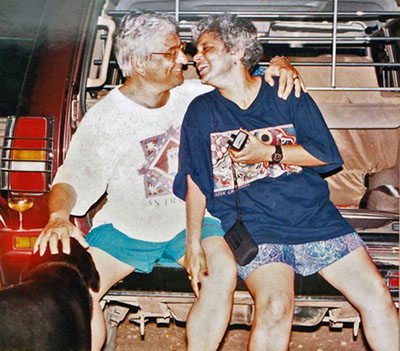
That night Rob and I listened to "Love Story" again and were engulfed with love and the most wonderful memories of our 25 years together.
What a perfect ending to a perfect weekend!
...but wait...this is not all. Our celebration went on!
 We had booked and paid for the balloon safari over the Serengeti, so once Rob was done with the UNICEF birthday celebration and all that hectic activity, we boarded a flight to Kilimanjaro to continue our sliver year’s festivity. Carlos, our driver and guide for this first-class tour was on the tarmac to meet us with a bunch of red roses from the tour company. We were driven to the beautiful new Serena Hotel and treated to an evening of song and dance by the Masai. What a thrill that was and how wonderfully they used their voices to produce unimaginable sounds.
We had booked and paid for the balloon safari over the Serengeti, so once Rob was done with the UNICEF birthday celebration and all that hectic activity, we boarded a flight to Kilimanjaro to continue our sliver year’s festivity. Carlos, our driver and guide for this first-class tour was on the tarmac to meet us with a bunch of red roses from the tour company. We were driven to the beautiful new Serena Hotel and treated to an evening of song and dance by the Masai. What a thrill that was and how wonderfully they used their voices to produce unimaginable sounds.
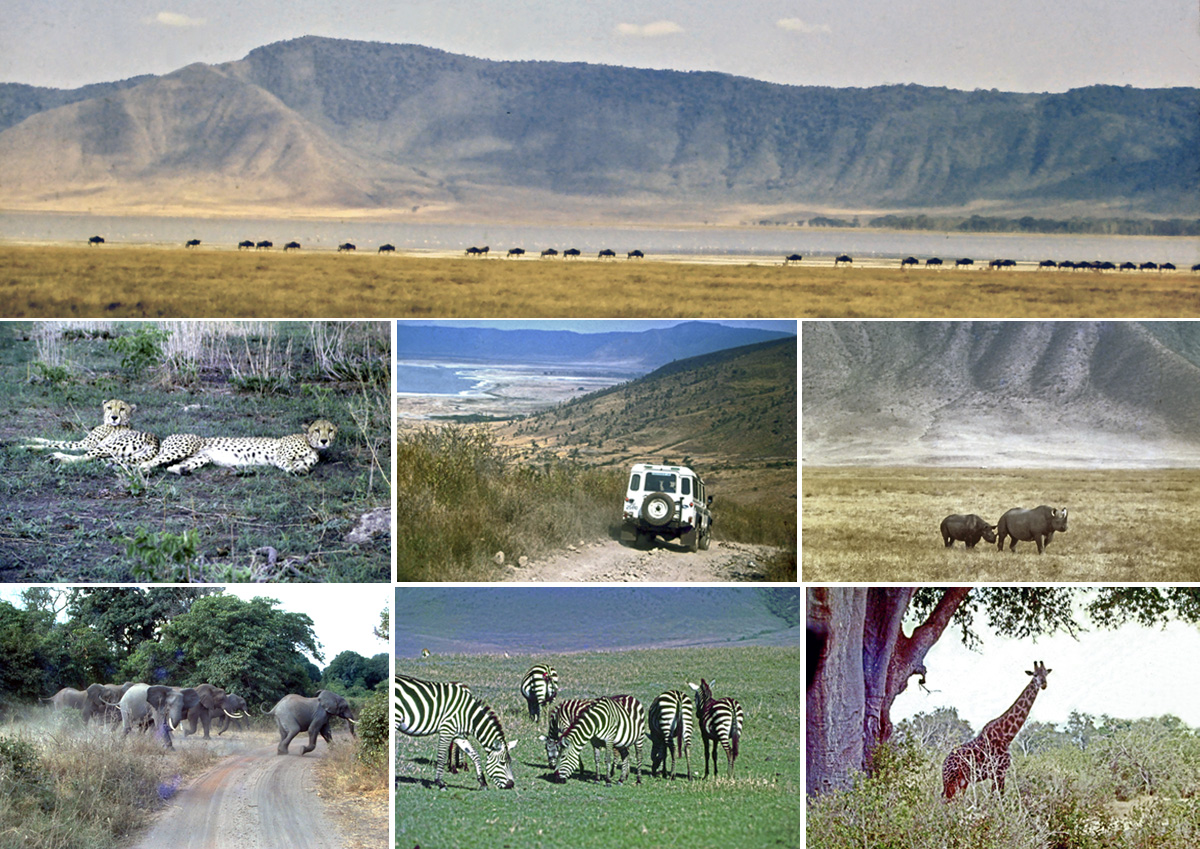
After a great rest and a sumptuous breakfast, Carlos had us sitting high up in the front seat of the Land Rover for our safari in the Ngorogoro Crater. The crater remains the most spectacular repository of wildlife on the planet. We saw zebra, wildebeest, lion, elephant, rhino, hippo, jackal, hundreds of birds, gazelle, and the list goes on and on!

At the end of around six hours of viewing, as we were driving out of the crater, Robert noticed a zebra that seemed very unsteady on its feet and was swaying from side to side. He thought the animal was sick and in distress and pointed it out to Carlos, who let out a whoop of joy and said, "You are very lucky people, that zebra is going to give birth, we will watch." The entire process took 22 minutes and happened in front of our eyes about 50 feet from where we were parked! Papa zebra and Aunties were all at hand standing at a safe distance to ward off opportunistic predators. Mama bore her pain stoically as she gazed glassy eyed at the distant hills, then when the pain became unbearable, she lay down on the ground and pushed the little one out. The baby arrived hind legs first and was covered in a blue sack which we presumed to be the placenta. It lay on the ground for a few moments all wet and fragile but ready to face the world as it began to struggle to stand on its own. After several tries it managed to get up, its hind legs splayed out behind it and with a tottering gait it circled mama trying to locate her teat. The colt was still attached to the umbilical cord but was soon freed by mama who stepped on it and severed it. Now the little one was free to suckle, while mama continued to gaze into the distance and munch on grass as papa chased off a couple of curious relatives. What a thrilling sighting that was!
The next day we drove for four hours to the Serengeti National Park, an area of 14,763 sq. kms. Over 1.4 million wildebeest and 200,000 zebra and gazelle, relentlessly tracked by Africa’s great predators, migrate in a clockwise fashion over 1,800 miles each year in search of rain-ripened grass. We were fortunate that the migration was taking place early in the year and we were in the right part of the park to catch this awesome spectacle. For as far as the eye could see were herds and herds and herds of animals. It was like the entire plain was alive and buzzing and moving and pulsating with life! Even the streams and lakes teemed with hippos, crocodiles and water birds. I have no adequate words to describe what we saw...
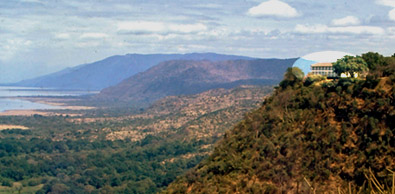 That evening the Serengeti Serena Lodge management was expecting a honeymooning couple and were quite surprised to see us silver haired folk! We were treated to a free bottle of wine and woken up at 4.45 AM to head out to the balloon launching area.
That evening the Serengeti Serena Lodge management was expecting a honeymooning couple and were quite surprised to see us silver haired folk! We were treated to a free bottle of wine and woken up at 4.45 AM to head out to the balloon launching area.

Unfortunately, the weather was terrible, foggy, rainy, and chilly, but none of this deterred our group of 8 and we happily got into those baskets lying down on our backs. Once in the air, it was glorious and we floated above those zebra and wildebeest watching the leaders and the followers, the stragglers, and the feisty teenagers. We also saw some civet cats which we were told is a rare sighting.
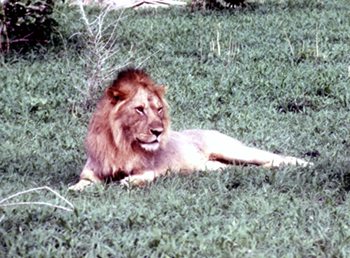
As we floated back towards earth and tumbled out of the basket, right in front of us, just a few feet away on the path, lay a beautiful male lion. He acted totally cool and nonchalant and was not to be moved by this bunch of gawking humans. He took his time, preening, cleaning, and enjoying the morning mist before he sauntered off into the far distance.

Our Champaign breakfast on Simba Kopje was canceled because of the rain, but we enjoyed it in the comfort of our hotel. We said goodbye to Carlos and our ballooning friends. We were then driven to a tiny airstrip where our own personal single-prop aircraft was waiting to fly us to Arusha airport, from there to catch the commercial flight back to Dar es Salaam. When the Welsh pilot heard this was our silver wedding celebration, he took us along a special scenic route to view beautiful scenery and picturesque Masai settlements, volcanoes, mountains, and streams.
And the icing on the cake? Our Adil was waiting for us at home. He had just arrived the day before from London to spend his Xmas holidays with us! Could there have been a more perfect ending?
